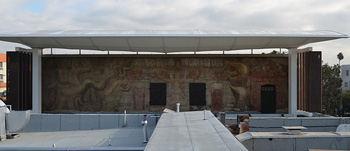
Exactly eighty years after it was first unveiled, America Tropical was welcomed back into the public eye by members of the Mexican and arts communities.
The mural on Olvera Street is by world-renowned Mexican artist David Alfaro Siqueiros. It was completed in 1932, but was painted over within a decade. This was widely seen as an attempt to squelch political expression by Mexican immigrants.
The organizers made it clear, that this time the mural is here to stay. The nearly ten-million-dollar project was funded by the Getty and the City of Los Angeles and included restoring the painting and installing a protective canopy and sun shades to protect it from further damage from sun, rain and birds.
Mayor Antonio Villaraigosa said Sequeiro’s work was an inspiration to political public artists all over the world. Villaraigosa spoke Tuesday morning about how the mural represents his Mexican grandmother’s journey to Los Angeles. She came here with nothing but a dream, he said in Spanish. “By conserving and displaying this masterpiece we are repaying our debt and honoring Siqueiros and his work” Villaraigosa said.
The mayor and others hinted at the challenges public art has faced in recent years. Ten years ago, the city of Los Angeles enacted a ban on signage that restricted murals, billboards and large-scale advertisements to designated parts of the city.
Rich advertisers began monopolizing space in the designated areas, which essentially silenced muralists and public artists. Over the last year, Councilman Jose Huizar has been pushing a mural ordinance to restore rights to public artists. “This is about history, it’s about censorship, it’s about art and it’s also about bringing Los Angeles together to a place that started the mural movement in the whole world,” Huizar said.
The ordinance, however, has been delayed because the city planning commission and artists can’t agree to the terms. Muralist Daniel Lahoda, the owner of LaLa Gallery and producer of the LA Freewalls Project, supports the ordinance.
“There’s such a great value in the public arts, there’s economic value, there is cultural value, aesthetic value and emotional value,” Lahoda said outside of Novelty Café, an eclectic coffee shop in the heart of L.A.’s arts district. “It just provides incredible energy overall to the lives of the community.”
Lahoda recently created a mural at the Skid Row Housing development. He believes that as long as property owners and community members support the art, the city should have no grounds to stop it. He said part of the problem is that the city makes money off illegal graffiti and doesn’t want to give up that revenue. “I have a hunch, a pretty strong hunch that the city attorney’s office is continuing to delay the mural ordinance specifically to maintain the power of the graffiti abatement community and their role in that community,” Lahoda said.
Representatives for the city attorney’s office did not respond to a request for comment. The mural ordinance is scheduled to be discussed at the city planning commission’s next meeting on Thursday morning.














